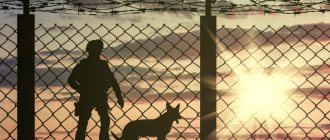ST 259 of the Criminal Code of the Russian Federation.
Destruction of critical habitats for organisms listed in the Red Book of the Russian Federation, resulting in the death of populations of these organisms, is punishable by a fine in the amount of three hundred thousand to five hundred thousand rubles or in the amount of the wages or other income of the convicted person for a period of two to three years, or by mandatory labor for a term of up to four hundred eighty hours, or restriction of liberty for a term of up to three years, or forced labor for a term of up to three years, or imprisonment for the same term.
Commentary to Art. 259 Criminal Code
1. Critical habitats for organisms listed in the Red Book of the Russian Federation are protective areas of territories and water areas necessary for the organisms to carry out their life cycles (reproduction, rearing of young animals, feeding, rest, migration, etc.). The habitat is called critical because it is the habitat of a population of rare or endangered organisms listed only in the Red Book of the Russian Federation.
2. The objective side of the crime consists of the act in the form of destruction of critical habitats for organisms listed in the Red Book of the Russian Federation, the resulting consequences in the form of death of populations of these organisms and the causal relationship between them.
Judicial practice under Article 259 of the Criminal Code of the Russian Federation
The appeal ruling of the Judicial Collegium for Criminal Cases of the Supreme Court of the Russian Federation dated August 29, 2019 in case No. 33-APU19-17sp. The
defense’s arguments about the inaccurate and incomplete presentation of the circumstances of the case in the protocol of the court session should be recognized as untenable since all the issues provided for were reflected in it Part 3 Art. 259 of the Criminal Code of the Russian Federation. The presiding judge's comments on the minutes of the court session were considered in accordance with the requirements of the law and, based on the results of the consideration, were reasonably rejected as not being confirmed.
Second commentary to Art. 259 of the Criminal Code of the Russian Federation
1. Critical habitats are specially designated areas (territories), part of the habitat, expressed in specific spatial boundaries, which are associated with the most significant stages of their life cycle for the conservation of animal populations; for plants - their entire life cycle.
2. Destruction means rendering these places completely unsuitable for the life cycles of plants and animals.
3. The subjective side involves an intentional or careless form of guilt.
4. The subject of the crime is a person who has reached the age of 16 years.
Commentary on Article 259 of the Criminal Code of the Russian Federation
1. In Russia, in accordance with the Laws on environmental protection, on wildlife and other regulatory legal acts, the Red Book of the Russian Federation and the Red Books of the constituent entities of the Russian Federation are maintained.
2. The Red Book of the Russian Federation is an official document containing a set of information on the status, distribution and measures for the protection of rare and endangered species (subspecies, populations) of wild animals and wild plants and fungi, permanently or temporarily living (growing) in natural conditions in territory (water area) of the Russian Federation, the continental shelf and in the exclusive economic zone of Russia. The Red Book of the Russian Federation is maintained by the Federal Service for Supervision of Natural Resources (Rosprirodnadzor) and its territorial bodies in cooperation with the Ministry of Agriculture of the Russian Federation (Ministry of Agriculture of Russia), the Federal Forestry Agency (Rosleskhoz) and their territorial (basin) bodies, the Russian Academy of Sciences, and also by executive authorities of the constituent entities of the Russian Federation. The basis for inclusion in the Red Book of the Russian Federation or changing the category (status) of a particular animal or plant object is data on a dangerous reduction in its number and (or) range, unfavorable changes in the conditions of existence of this object, or other data indicating the need to take special measures for its preservation and restoration (Regulations on the procedure for maintaining the Red Book of the Russian Federation, approved by Order of the State Committee for Ecology of Russia 03.10.1997 N 419-a <1>; Decree of the Government of the Russian Federation of 19.02.1996 N 158 “On the Red Book of the Russian Federation” <2> ). ——————————— <1> BNA. 1998. N 2.
<2> Northwestern Russian Federation. 1996. N 9. Art. 808.
3. The public danger of destruction of critical habitats for organisms listed in the Red Book of the Russian Federation lies in undermining the environmental safety of Russia and the death of populations of these organisms.
The article describes socially dangerous acts that fall into the category of crimes of medium gravity.
4. The main objects of criminal encroachment are: environmental safety of society, ensured by the protection, rational use and reproduction of populations of organisms listed in the Red Book of the Russian Federation; ecological state of populations of these organisms and their critical habitats.
5. Subjects of encroachment - populations of organisms listed in the Red Book of the Russian Federation, their critical habitats.
5.1. A population of organisms is a collection of individuals of the same species, occupying a limited habitat under natural conditions, i.e. part of a given biocenosis - a community of animals and plants of more or less constant species composition, occupying a homogeneous area of territory.
5.2. Critical habitats are areas of territory adapted for life (survival) in a state of natural freedom and occupied by organisms listed in the Red Book.
6. The objective side of the crime is expressed in the destruction of critical habitats for organisms listed in the Red Book of the Russian Federation. The implementation of this act is possible in the form of both action and inaction of the subject of the criminal offense. In the first case, the criminal behavior of the guilty person may be associated with a violation of the procedure for removing wildlife objects listed in the Red Book from their habitat; in the second - with the negligent attitude of the perpetrator towards his professional duties (non-fulfillment, non-compliance), which resulted in the destruction of critical habitats for organisms listed in the Red Book of the Russian Federation.
7. The disposition of the article has a reference-blanket nature, since in order to properly qualify a socially dangerous act as a crime, it refers the law enforcement officer to other laws and by-laws, including: the Red Book of the Russian Federation; Order of Rosprirodnadzor dated 02.09.2004 N 9 “On licensing activities in the Federal Service for Supervision of Natural Resources” (as amended on 12.08.2005), which approved: Temporary procedure for issuing permits for the extraction of wildlife objects belonging to species listed in Red Book of the Russian Federation, Temporary Regulations on the procedure for making decisions on issuing licenses for the export of resources of animal and plant origin, issued by the Ministry of Economic Development of Russia; The procedure for issuing permits for the extraction of wildlife objects belonging to species listed in the Red Book of the Russian Federation, approved. By Order of the Ministry of Natural Resources of Russia dated September 3, 2003 N 799 (as amended on June 28, 2006) <1>; Rules for obtaining objects of fauna belonging to species listed in the Red Book of the Russian Federation, approved. Decree of the Government of the Russian Federation dated January 6, 1997 N 13 (as amended on December 14, 2004) <2>, etc. ——————————— <1> RG. N 202. 2003; N 183. 2006.
<2> Northwestern Russian Federation. 1997. N 3. Art. 385; 2003. N 17. Art. 1621; 2004. N 51. Art. 5188.
8. The procedure for obtaining objects of wildlife listed in the Red Book of the Russian Federation is determined by the Rules for obtaining objects of wildlife belonging to species listed in the Red Book of the Russian Federation, the Procedure for issuing permits for obtaining objects of wildlife belonging to species listed in the Red Book of the Russian Federation Federation (see also the Regulations on the procedure for maintaining the Red Book of the Russian Federation).
8.1. The removal of species of flora and fauna listed in the Red Book of the Russian Federation from their habitat is permitted in exceptional cases in order to preserve these objects, regulate their numbers, protect public health, eliminate the threat to human life, protect agricultural and other domestic animals from mass diseases, and ensure the traditional needs of indigenous peoples. small peoples based on permission from Rosprirodnadzor. The timing and methods of obtaining objects of fauna should not cause damage to the natural populations of these animal species and their habitats (see Rules for obtaining objects of fauna belonging to species listed in the Red Book of the Russian Federation; Procedure for issuing permits for obtaining objects of fauna belonging to to species listed in the Red Book of the Russian Federation).
9. According to the legislative structure, the corpus delicti is material. The crime is completed (by composition) at the moment of death of the populations of organisms listed in the Red Book of the Russian Federation.
10. Damage caused by the destruction of critical habitats is calculated according to taxes, approved. By Order of the Russian Ministry of Natural Resources dated May 4, 1994 N 126.
11. The subjective side of the crime is characterized by guilt in the form of intent or negligence. For more details see Art. 25 - 26.
12. The subject of a criminal offense is a physically sane person who has reached the age of 16 at the time of the commission of the crime. The functions performed, position held or official position have no significance for qualifying a socially dangerous act as a crime.
Commentary on Article 259 of the Criminal Code of the Russian Federation
In order to prevent the decline of populations of wild animal and plant species, not only they themselves, but also their habitats are subject to protection.
Today, about a thousand species of vertebrate animals (almost twenty-five percent) and twenty-five thousand plant species are threatened with extinction in the world. The Red Book of the Russian Federation contains about six hundred species of plants and about three hundred species of animals. Sixty-seven percent of animal species are included in the Red Book of the Russian Federation due to habitat destruction.
The danger of this crime lies not only in the fact that it leads to the disappearance of animals and plants from the face of the Earth, but also in the fact that an invaluable gene pool is lost and species degenerate.
The crime encroaches on relations for the protection of organisms listed in the Red Book of the Russian Federation and their critical habitats, which are the object of the crime.
The protection of rare and endangered species of animals and plants is regulated by numerous regulatory legal acts. All of them can be divided into two groups: general and special. General laws, in particular, include: Federal laws dated January 10, 2002 N 7-FZ “On environmental protection” <1>, dated March 14, 1995 N 33-FZ “On specially protected natural areas” <2> , dated March 22, 1995 N 52-FZ “On the Animal World” <3>, dated November 30, 1995 N 187-FZ “On the Continental Shelf of the Russian Federation” <4>; Water Code of the Russian Federation, LC RF.
——————————— <1> NW RF. 2002. N 2. Art. 133. <2> NW RF. 1995. N 12. Art. 1024. <3> NW RF. 1995. N 17. Art. 1462. <4> NW RF. 1995. N 49. Art. 4694; 2005. N 19. Art. 1752.
Special acts should include, for example, Resolutions of the Government of the Russian Federation dated February 19, 1996 N 158 “On the Red Book of the Russian Federation” <1>, dated February 19, 1996 N 156 “On the procedure for issuing permits (administrative licenses) for the circulation of wild animals belonging to species listed in the Red Book of the Russian Federation" (as amended on December 14, 2004) <2>, dated January 6, 1997 N 13 "On approval of the Rules for obtaining objects of the animal world belonging to species listed to the Red Book of the Russian Federation" (as amended on December 14, 2004) <3>.
——————————— <1> NW RF. 1996. N 9. Art. 808. <2> NW RF. 1996. N 9. Art. 807. <3> NW RF. 1997. N 3. Art. 385.
The Red Book of the Russian Federation is a kind of cadastre of rare and endangered species of plants and animals. Inclusion in the Red Book of the Russian Federation means the widespread removal of animals and plants from economic circulation and a complete ban on any use (collecting, storing berries, plants, shooting, trapping animals, changing habitat conditions, etc.). The procedure for maintaining the Red Book of the Russian Federation is determined by the Decree of the Government of the Russian Federation of February 19, 1996 “On the Red Book of the Russian Federation.”
The subject of the crime is organisms listed in the Red Book of the Russian Federation: animals of various species (mammals, fish, insects, etc.) and various types of plants.
Critical habitats are specially designated protective areas of the natural environment (steppe, forest, water areas, etc.), in which organisms listed in the Red Book of the Russian Federation live (grow) in a state of natural freedom. These areas are of a protective nature; all types of economic activity are prohibited in them, or certain types of economic activity are prohibited at all times of the year or activities in certain seasons of the year, or the timing and methods of its implementation are regulated.
The habitat is called critical because it is the habitat of populations of rare or endangered species of organisms listed in the Red Book of the Russian Federation.
Within the meaning of Art. 259 of the Criminal Code of the Russian Federation and the norms of regulatory acts to which it refers, critical habitats are subject to protection not in themselves, not for the sake of their conservation, but for the preservation and survival of the populations of “Red Book” organisms living in them.
Inclusion in the Red Book of the Russian Federation means the widespread removal of animals and plants from economic circulation and a complete ban on any use (picking, storing berries, plants, shooting, catching animals, changing living conditions, etc.), with the exception of use for reproduction and conservation of species carried out on the basis of special permits.
In the Red Book of the Russian Federation, in accordance with the Red Book of the International Union for Conservation of Nature and Natural Resources (IUCN), five categories of plants and animals are distinguished:
1) endangered, the salvation of which is impossible without the implementation of special measures;
2) whose numbers are relatively high, but are declining catastrophically quickly, which in the near future may put them at risk of extinction;
3) rare, which are not in danger of extinction, but due to unfavorable changes in the habitat, due to their small numbers, they may become endangered;
4) whose biology has not been sufficiently studied, but their condition is alarming;
5) restored species, the condition of which, thanks to the protection measures taken, does not cause concern, but they require constant monitoring.
In connection with the above, in our opinion, “critical habitat”, the law designates the place where the crime was committed, and not its subject.
From the objective side, the crime is expressed in the destruction of critical habitats for organisms listed in the Red Book of the Russian Federation.
Destruction is the rendering of critical habitats completely unsuitable for the existence of these organisms, excluding the implementation of their life cycles.
The methods of destruction of a critical habitat do not matter: poisoning, contamination of the territory, burning or deforestation, flooding of the habitat, creating a disturbance factor through economic activity, etc. If the destruction of the habitats of animals and plants specified in Art. 259 of the Criminal Code of the Russian Federation, occurred in violation of the rules of environmental protection during the performance of work (Article 246 of the Criminal Code of the Russian Federation), destruction or damage to forests (Article 261 of the Criminal Code of the Russian Federation), violation of the regime of nature reserves and other specially protected areas (Article 262 of the Criminal Code of the Russian Federation), violation of the rules for the protection of fish stocks (Article 257 of the Criminal Code of the Russian Federation), pollution of the natural environment (Articles 250, 251, 252, 254 of the Criminal Code of the Russian Federation), then liability arises as under Art. 259 of the Criminal Code of the Russian Federation, and under the listed articles, since they do not cover the destruction of populations of “Red Book” animals and plants.
The corpus delicti is material. The crime is considered completed from the moment the consequences occur in the form of death of populations of organisms listed in the Red Book of the Russian Federation. Their death is an obligatory sign of the composition.
A causal relationship must be established between consequences and actions.
A population is a collection of individuals of the same species that occupies a certain space for a long time and reproduces itself over a large number of generations. The population can occupy a significant space (distribution area), up to the entire territory of the Russian Federation and beyond.
When applying this article, in our opinion, the concept of “population habitat” should be interpreted in a limited way and only the territory within certain boundaries (reservoir, forest, tract, wetland, etc.) should be considered as such. Otherwise Art. 259 of the Criminal Code of the Russian Federation is practically inapplicable.
The subjective side of the crime involves an intentional or careless form of guilt.
With direct intent, a person, when destroying a critical habitat, is aware of the social danger of his actions, foresees the possibility or inevitability of the death of populations of organisms listed in the Red Book of the Russian Federation and desires the occurrence of these consequences. With indirect intent, a person is aware of the social danger of his actions, foresees the possibility of the death of populations of “Red Book” organisms, does not want, but consciously allows these consequences or is indifferent to them.
In case of a careless form of guilt, a person does not foresee the possibility of the occurrence of the consequences of his actions specified in the law, although with the necessary care and forethought he should and could have foreseen these consequences (criminal negligence), or he foresees the possibility of their occurrence, but without sufficient grounds for this he arrogantly hopes to prevent consequences (criminal frivolity).
The general subject of the crime is a sane person who has reached the age of sixteen years.



